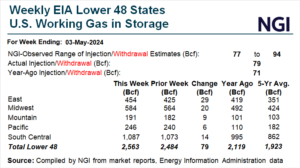LNG | LNG Insight | NGI All News Access | NGI The Weekly Gas Market Report
Louisiana LNG Departs for Global Market Uneasy Over Ukraine
The first cargo of liquefied natural gas (LNG) has departed the Calcasieu Pass export terminal in Louisiana, providing additional American supplies to a tight market uneasy about war in Ukraine.
Venture Global LNG Inc., which owns Calcasieu Pass, said a subsidiary of Jera Co. Inc. chartered the Greece-flagged vessel Yiannis to load the first cargo. The vessel, which arrived at Calcasieu Pass Feb. 7, had not declared a destination as of Tuesday. It is likely, however, that the ship would remain in the Atlantic Basin given the clear premiums for U.S. LNG in Europe.
Calcasieu Pass produced its first LNG in January. Venture is installing 18 modular liquefaction trains in nine blocks. While commissioning continues, the United States is expected to have the largest liquefaction capacity in the world when the 1.6 Bcf/d terminal comes online, which is expected by the end of the year. At that point, peak domestic LNG capacity is expected to increase to 13.9 Bcf/d.
The commissioning cargoes also come at a time when Europe could need additional supplies as the fighting in Ukraine threatens to disrupt the continent’s pipeline imports from Russia. European natural gas prices were up again on Tuesday as the conflict outweighed other market forces.
The threat of sanctions against Russian energy exports has posed the greatest threat and caused prices to waver since the attacks began last Thursday. However, swings have been eased somewhat by steady supplies and as winter is nearing an end. A flood of U.S. LNG supplies and a milder-than-expected winter have helped European storage inventories creep back into the five-year range.
The United States provided about half of all Europe’s LNG imports in January. Preliminary data showed the country provided a similar portion of the 10.8 million tons offloaded on the continent last month, according to Kpler.
Energy exports have so far been excluded from the West’s sanctions against Russia, but the market remains on edge as further measures could limit flows.
“The turmoil in global gas markets expected as a result of the continuing conflict in Ukraine has not yet materialized, with gas flows from Russia actually increasing,” said Rystad Energy analyst Kaushal Ramesh.
“At this moment, a disruption in flows is more likely to stem from damage to infrastructure,” he added. “However, as the situation is evolving rapidly, the risk of disruptions due to sanctions on energy remains a real possibility.”
Russian gas entering Europe remains strong. Flows have been high since fighting broke out last week. Flows to the continent were running above 100 million cubic meters again on Tuesday.
Given strong demand, feed gas deliveries to U.S. terminals have been running at or near capacity in recent weeks. They dipped last week after Freeport LNG tripped offline, but bounced back Tuesday. NGI data showed nominations for the day at 12.5 Bcf.
© 2024 Natural Gas Intelligence. All rights reserved.
ISSN © 1532-1231 | ISSN © 2577-9877 | ISSN © 1532-1266 |


